Sustainability of Purchasing and Supply
VerifiedAdded on 2023/02/06
|13
|3526
|46
AI Summary
This report explores the concept of sustainability in purchasing and supply, with a focus on the sustainable supply management of DHL. It discusses the benefits and problems of sustainable purchasing, the role of sustainability in procurement, sustainability metrics, governance mechanisms, and the influence of sustainable supply management on buyer-supplier relationships. Recommendations include top management support and commitment to drive sustainable procurement.
Contribute Materials
Your contribution can guide someone’s learning journey. Share your
documents today.
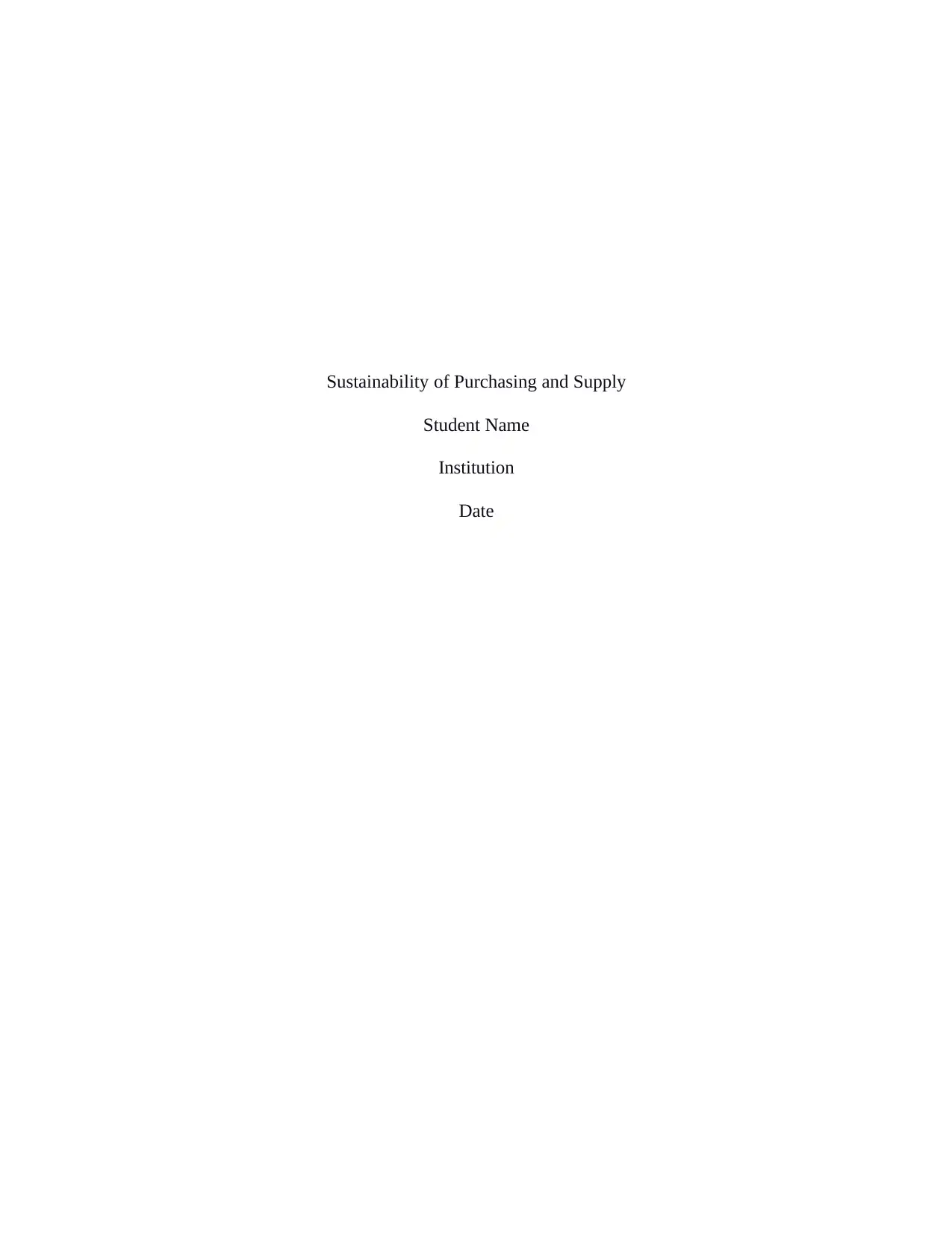
Sustainability of Purchasing and Supply
Student Name
Institution
Date
Student Name
Institution
Date
Secure Best Marks with AI Grader
Need help grading? Try our AI Grader for instant feedback on your assignments.
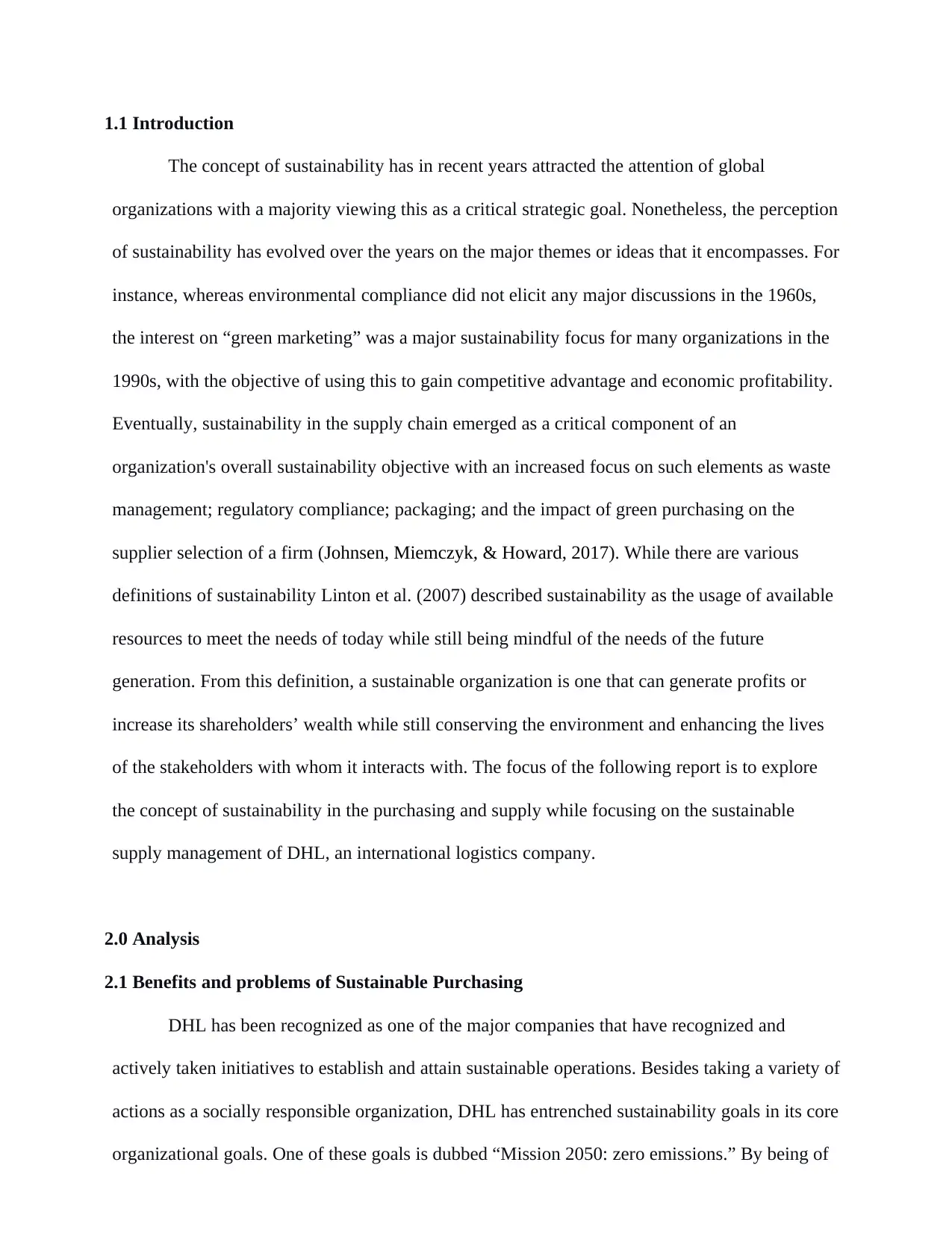
1.1 Introduction
The concept of sustainability has in recent years attracted the attention of global
organizations with a majority viewing this as a critical strategic goal. Nonetheless, the perception
of sustainability has evolved over the years on the major themes or ideas that it encompasses. For
instance, whereas environmental compliance did not elicit any major discussions in the 1960s,
the interest on “green marketing” was a major sustainability focus for many organizations in the
1990s, with the objective of using this to gain competitive advantage and economic profitability.
Eventually, sustainability in the supply chain emerged as a critical component of an
organization's overall sustainability objective with an increased focus on such elements as waste
management; regulatory compliance; packaging; and the impact of green purchasing on the
supplier selection of a firm (Johnsen, Miemczyk, & Howard, 2017). While there are various
definitions of sustainability Linton et al. (2007) described sustainability as the usage of available
resources to meet the needs of today while still being mindful of the needs of the future
generation. From this definition, a sustainable organization is one that can generate profits or
increase its shareholders’ wealth while still conserving the environment and enhancing the lives
of the stakeholders with whom it interacts with. The focus of the following report is to explore
the concept of sustainability in the purchasing and supply while focusing on the sustainable
supply management of DHL, an international logistics company.
2.0 Analysis
2.1 Benefits and problems of Sustainable Purchasing
DHL has been recognized as one of the major companies that have recognized and
actively taken initiatives to establish and attain sustainable operations. Besides taking a variety of
actions as a socially responsible organization, DHL has entrenched sustainability goals in its core
organizational goals. One of these goals is dubbed “Mission 2050: zero emissions.” By being of
The concept of sustainability has in recent years attracted the attention of global
organizations with a majority viewing this as a critical strategic goal. Nonetheless, the perception
of sustainability has evolved over the years on the major themes or ideas that it encompasses. For
instance, whereas environmental compliance did not elicit any major discussions in the 1960s,
the interest on “green marketing” was a major sustainability focus for many organizations in the
1990s, with the objective of using this to gain competitive advantage and economic profitability.
Eventually, sustainability in the supply chain emerged as a critical component of an
organization's overall sustainability objective with an increased focus on such elements as waste
management; regulatory compliance; packaging; and the impact of green purchasing on the
supplier selection of a firm (Johnsen, Miemczyk, & Howard, 2017). While there are various
definitions of sustainability Linton et al. (2007) described sustainability as the usage of available
resources to meet the needs of today while still being mindful of the needs of the future
generation. From this definition, a sustainable organization is one that can generate profits or
increase its shareholders’ wealth while still conserving the environment and enhancing the lives
of the stakeholders with whom it interacts with. The focus of the following report is to explore
the concept of sustainability in the purchasing and supply while focusing on the sustainable
supply management of DHL, an international logistics company.
2.0 Analysis
2.1 Benefits and problems of Sustainable Purchasing
DHL has been recognized as one of the major companies that have recognized and
actively taken initiatives to establish and attain sustainable operations. Besides taking a variety of
actions as a socially responsible organization, DHL has entrenched sustainability goals in its core
organizational goals. One of these goals is dubbed “Mission 2050: zero emissions.” By being of
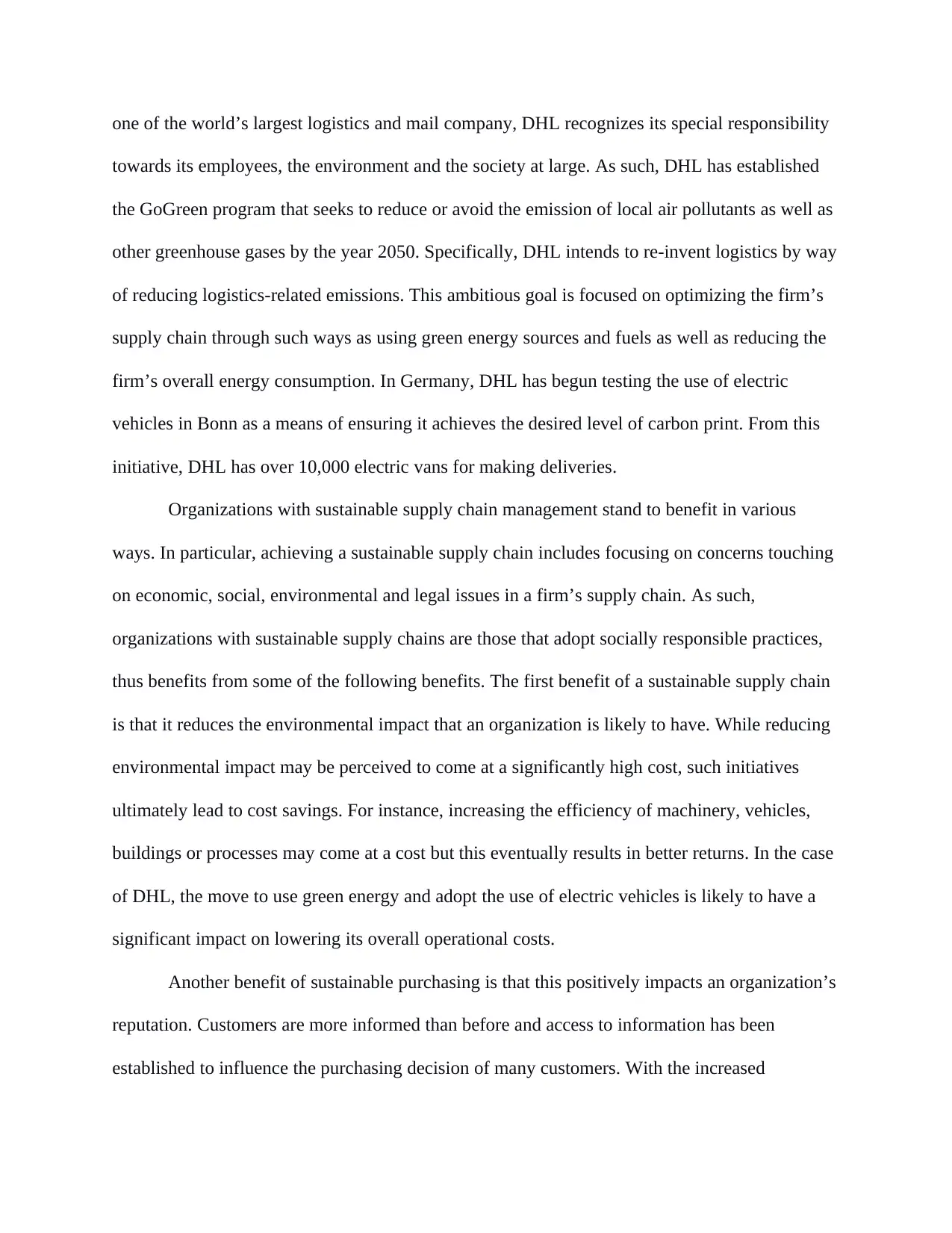
one of the world’s largest logistics and mail company, DHL recognizes its special responsibility
towards its employees, the environment and the society at large. As such, DHL has established
the GoGreen program that seeks to reduce or avoid the emission of local air pollutants as well as
other greenhouse gases by the year 2050. Specifically, DHL intends to re-invent logistics by way
of reducing logistics-related emissions. This ambitious goal is focused on optimizing the firm’s
supply chain through such ways as using green energy sources and fuels as well as reducing the
firm’s overall energy consumption. In Germany, DHL has begun testing the use of electric
vehicles in Bonn as a means of ensuring it achieves the desired level of carbon print. From this
initiative, DHL has over 10,000 electric vans for making deliveries.
Organizations with sustainable supply chain management stand to benefit in various
ways. In particular, achieving a sustainable supply chain includes focusing on concerns touching
on economic, social, environmental and legal issues in a firm’s supply chain. As such,
organizations with sustainable supply chains are those that adopt socially responsible practices,
thus benefits from some of the following benefits. The first benefit of a sustainable supply chain
is that it reduces the environmental impact that an organization is likely to have. While reducing
environmental impact may be perceived to come at a significantly high cost, such initiatives
ultimately lead to cost savings. For instance, increasing the efficiency of machinery, vehicles,
buildings or processes may come at a cost but this eventually results in better returns. In the case
of DHL, the move to use green energy and adopt the use of electric vehicles is likely to have a
significant impact on lowering its overall operational costs.
Another benefit of sustainable purchasing is that this positively impacts an organization’s
reputation. Customers are more informed than before and access to information has been
established to influence the purchasing decision of many customers. With the increased
towards its employees, the environment and the society at large. As such, DHL has established
the GoGreen program that seeks to reduce or avoid the emission of local air pollutants as well as
other greenhouse gases by the year 2050. Specifically, DHL intends to re-invent logistics by way
of reducing logistics-related emissions. This ambitious goal is focused on optimizing the firm’s
supply chain through such ways as using green energy sources and fuels as well as reducing the
firm’s overall energy consumption. In Germany, DHL has begun testing the use of electric
vehicles in Bonn as a means of ensuring it achieves the desired level of carbon print. From this
initiative, DHL has over 10,000 electric vans for making deliveries.
Organizations with sustainable supply chain management stand to benefit in various
ways. In particular, achieving a sustainable supply chain includes focusing on concerns touching
on economic, social, environmental and legal issues in a firm’s supply chain. As such,
organizations with sustainable supply chains are those that adopt socially responsible practices,
thus benefits from some of the following benefits. The first benefit of a sustainable supply chain
is that it reduces the environmental impact that an organization is likely to have. While reducing
environmental impact may be perceived to come at a significantly high cost, such initiatives
ultimately lead to cost savings. For instance, increasing the efficiency of machinery, vehicles,
buildings or processes may come at a cost but this eventually results in better returns. In the case
of DHL, the move to use green energy and adopt the use of electric vehicles is likely to have a
significant impact on lowering its overall operational costs.
Another benefit of sustainable purchasing is that this positively impacts an organization’s
reputation. Customers are more informed than before and access to information has been
established to influence the purchasing decision of many customers. With the increased
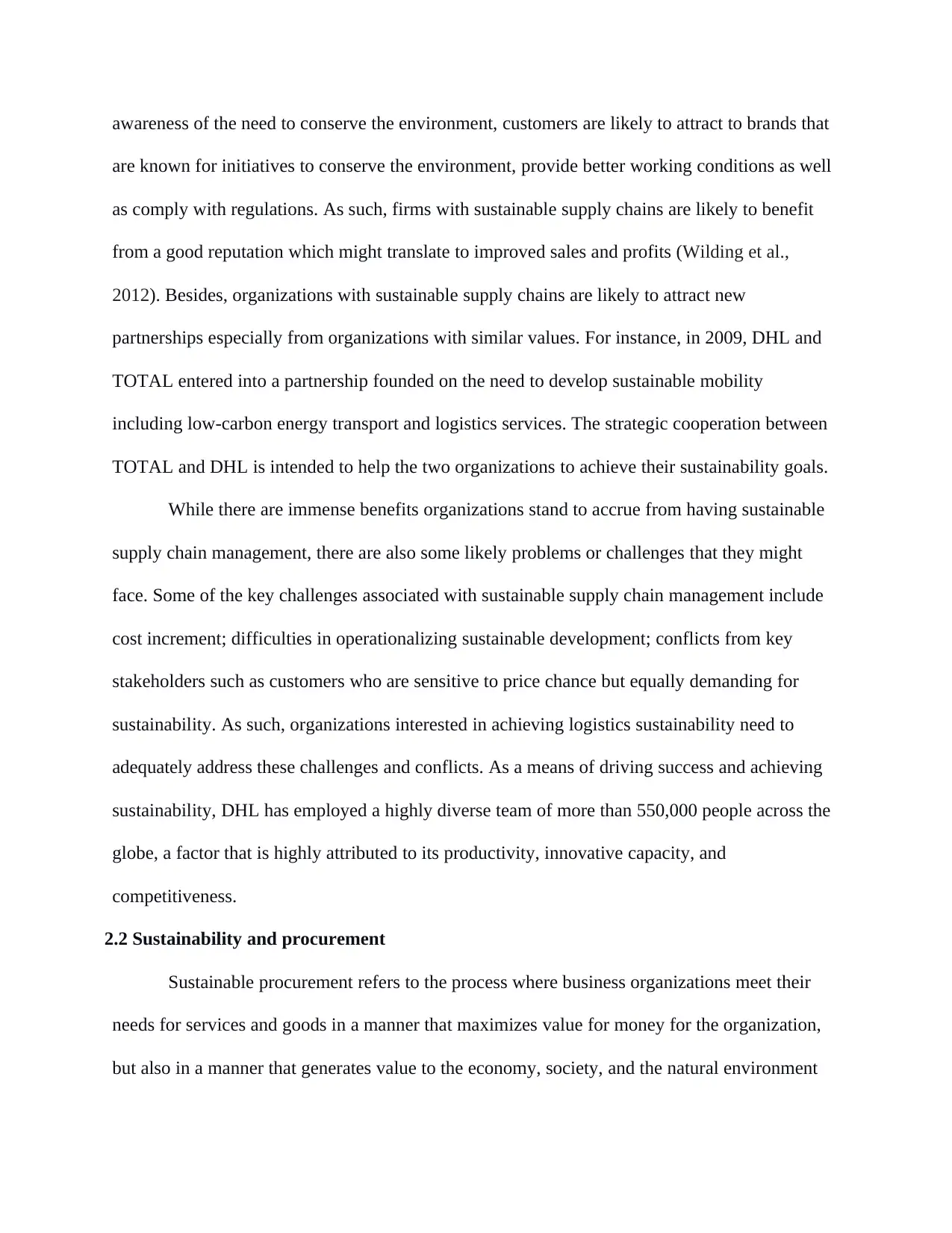
awareness of the need to conserve the environment, customers are likely to attract to brands that
are known for initiatives to conserve the environment, provide better working conditions as well
as comply with regulations. As such, firms with sustainable supply chains are likely to benefit
from a good reputation which might translate to improved sales and profits (Wilding et al.,
2012). Besides, organizations with sustainable supply chains are likely to attract new
partnerships especially from organizations with similar values. For instance, in 2009, DHL and
TOTAL entered into a partnership founded on the need to develop sustainable mobility
including low-carbon energy transport and logistics services. The strategic cooperation between
TOTAL and DHL is intended to help the two organizations to achieve their sustainability goals.
While there are immense benefits organizations stand to accrue from having sustainable
supply chain management, there are also some likely problems or challenges that they might
face. Some of the key challenges associated with sustainable supply chain management include
cost increment; difficulties in operationalizing sustainable development; conflicts from key
stakeholders such as customers who are sensitive to price chance but equally demanding for
sustainability. As such, organizations interested in achieving logistics sustainability need to
adequately address these challenges and conflicts. As a means of driving success and achieving
sustainability, DHL has employed a highly diverse team of more than 550,000 people across the
globe, a factor that is highly attributed to its productivity, innovative capacity, and
competitiveness.
2.2 Sustainability and procurement
Sustainable procurement refers to the process where business organizations meet their
needs for services and goods in a manner that maximizes value for money for the organization,
but also in a manner that generates value to the economy, society, and the natural environment
are known for initiatives to conserve the environment, provide better working conditions as well
as comply with regulations. As such, firms with sustainable supply chains are likely to benefit
from a good reputation which might translate to improved sales and profits (Wilding et al.,
2012). Besides, organizations with sustainable supply chains are likely to attract new
partnerships especially from organizations with similar values. For instance, in 2009, DHL and
TOTAL entered into a partnership founded on the need to develop sustainable mobility
including low-carbon energy transport and logistics services. The strategic cooperation between
TOTAL and DHL is intended to help the two organizations to achieve their sustainability goals.
While there are immense benefits organizations stand to accrue from having sustainable
supply chain management, there are also some likely problems or challenges that they might
face. Some of the key challenges associated with sustainable supply chain management include
cost increment; difficulties in operationalizing sustainable development; conflicts from key
stakeholders such as customers who are sensitive to price chance but equally demanding for
sustainability. As such, organizations interested in achieving logistics sustainability need to
adequately address these challenges and conflicts. As a means of driving success and achieving
sustainability, DHL has employed a highly diverse team of more than 550,000 people across the
globe, a factor that is highly attributed to its productivity, innovative capacity, and
competitiveness.
2.2 Sustainability and procurement
Sustainable procurement refers to the process where business organizations meet their
needs for services and goods in a manner that maximizes value for money for the organization,
but also in a manner that generates value to the economy, society, and the natural environment
Secure Best Marks with AI Grader
Need help grading? Try our AI Grader for instant feedback on your assignments.
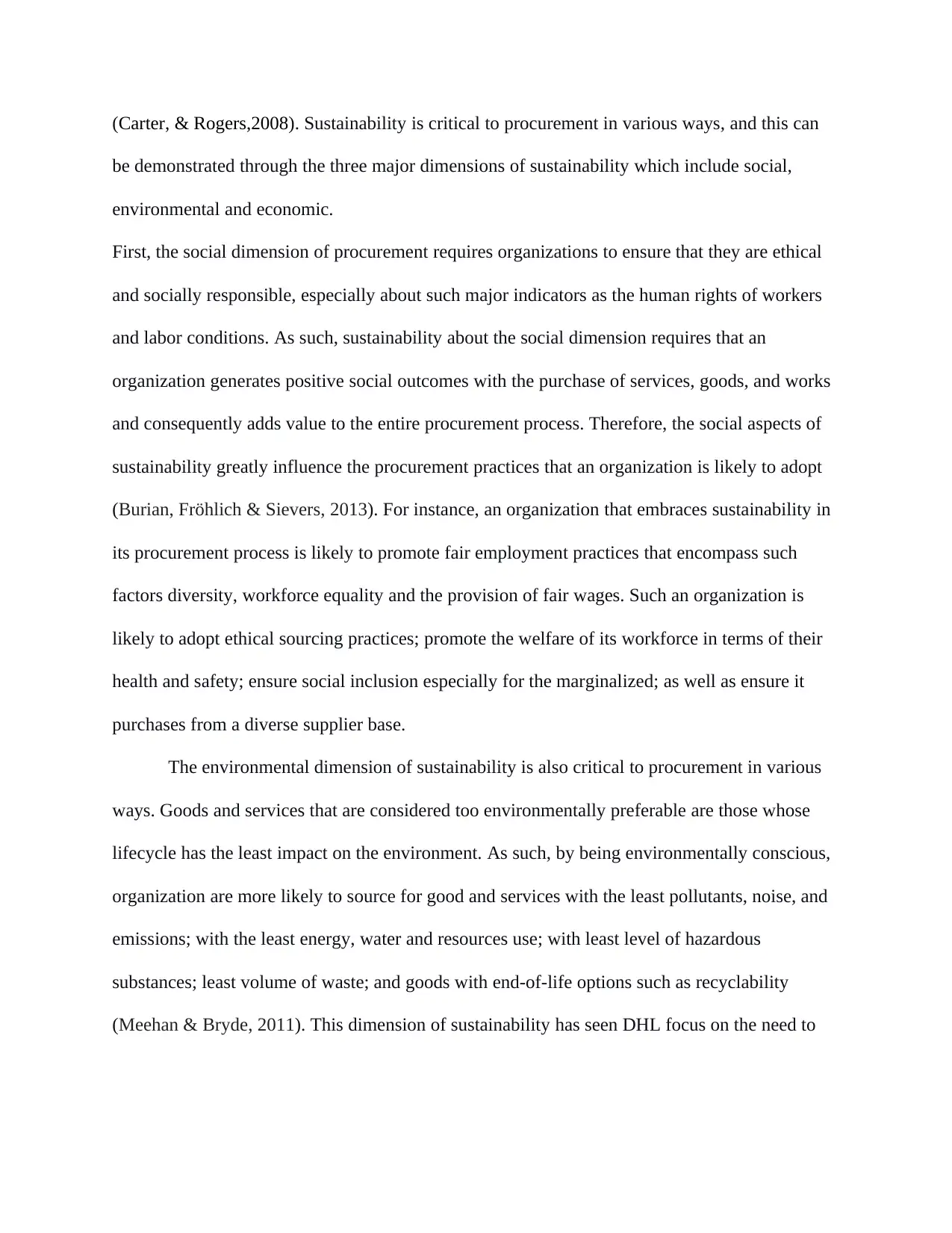
(Carter, & Rogers,2008). Sustainability is critical to procurement in various ways, and this can
be demonstrated through the three major dimensions of sustainability which include social,
environmental and economic.
First, the social dimension of procurement requires organizations to ensure that they are ethical
and socially responsible, especially about such major indicators as the human rights of workers
and labor conditions. As such, sustainability about the social dimension requires that an
organization generates positive social outcomes with the purchase of services, goods, and works
and consequently adds value to the entire procurement process. Therefore, the social aspects of
sustainability greatly influence the procurement practices that an organization is likely to adopt
(Burian, Fröhlich & Sievers, 2013). For instance, an organization that embraces sustainability in
its procurement process is likely to promote fair employment practices that encompass such
factors diversity, workforce equality and the provision of fair wages. Such an organization is
likely to adopt ethical sourcing practices; promote the welfare of its workforce in terms of their
health and safety; ensure social inclusion especially for the marginalized; as well as ensure it
purchases from a diverse supplier base.
The environmental dimension of sustainability is also critical to procurement in various
ways. Goods and services that are considered too environmentally preferable are those whose
lifecycle has the least impact on the environment. As such, by being environmentally conscious,
organization are more likely to source for good and services with the least pollutants, noise, and
emissions; with the least energy, water and resources use; with least level of hazardous
substances; least volume of waste; and goods with end-of-life options such as recyclability
(Meehan & Bryde, 2011). This dimension of sustainability has seen DHL focus on the need to
be demonstrated through the three major dimensions of sustainability which include social,
environmental and economic.
First, the social dimension of procurement requires organizations to ensure that they are ethical
and socially responsible, especially about such major indicators as the human rights of workers
and labor conditions. As such, sustainability about the social dimension requires that an
organization generates positive social outcomes with the purchase of services, goods, and works
and consequently adds value to the entire procurement process. Therefore, the social aspects of
sustainability greatly influence the procurement practices that an organization is likely to adopt
(Burian, Fröhlich & Sievers, 2013). For instance, an organization that embraces sustainability in
its procurement process is likely to promote fair employment practices that encompass such
factors diversity, workforce equality and the provision of fair wages. Such an organization is
likely to adopt ethical sourcing practices; promote the welfare of its workforce in terms of their
health and safety; ensure social inclusion especially for the marginalized; as well as ensure it
purchases from a diverse supplier base.
The environmental dimension of sustainability is also critical to procurement in various
ways. Goods and services that are considered too environmentally preferable are those whose
lifecycle has the least impact on the environment. As such, by being environmentally conscious,
organization are more likely to source for good and services with the least pollutants, noise, and
emissions; with the least energy, water and resources use; with least level of hazardous
substances; least volume of waste; and goods with end-of-life options such as recyclability
(Meehan & Bryde, 2011). This dimension of sustainability has seen DHL focus on the need to
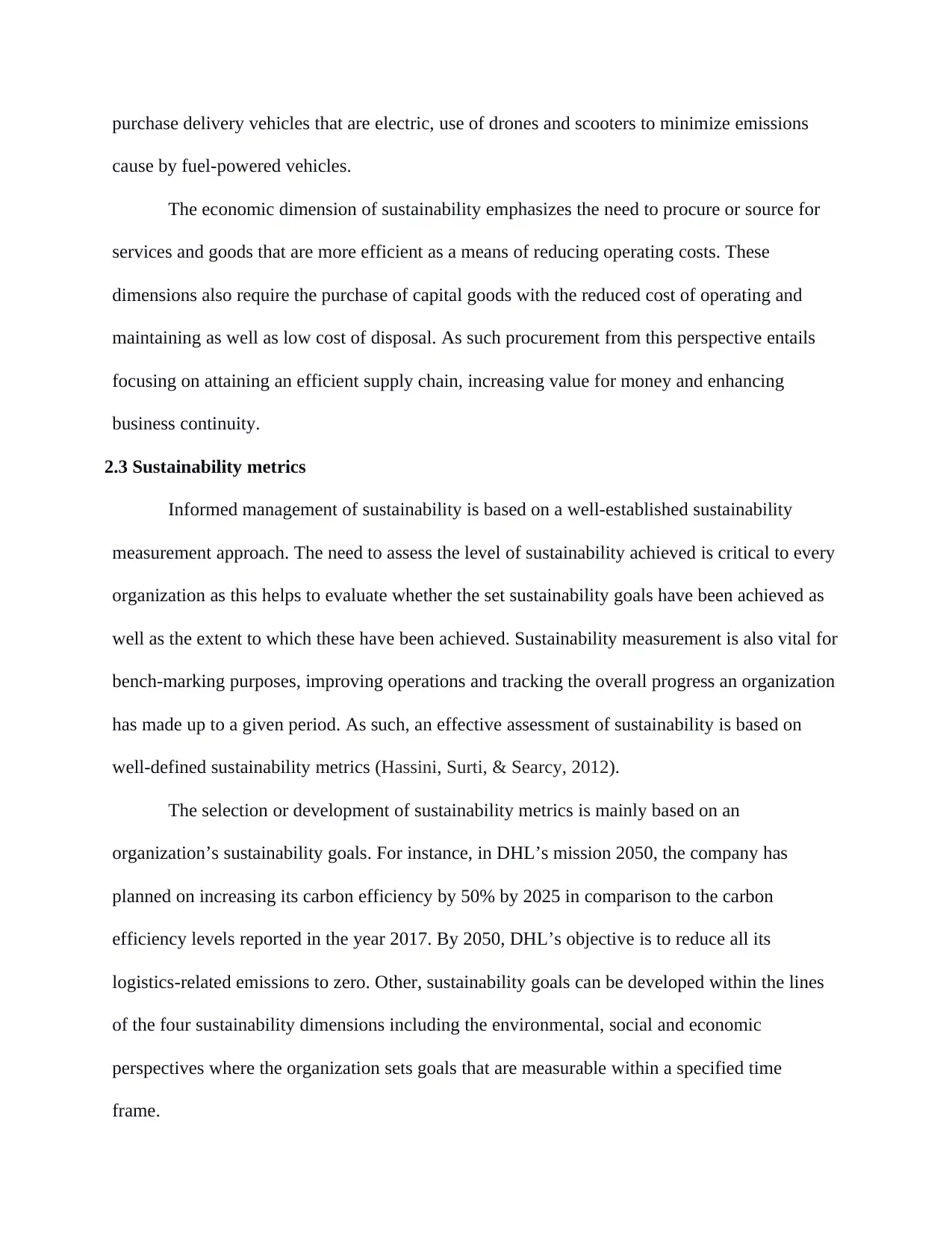
purchase delivery vehicles that are electric, use of drones and scooters to minimize emissions
cause by fuel-powered vehicles.
The economic dimension of sustainability emphasizes the need to procure or source for
services and goods that are more efficient as a means of reducing operating costs. These
dimensions also require the purchase of capital goods with the reduced cost of operating and
maintaining as well as low cost of disposal. As such procurement from this perspective entails
focusing on attaining an efficient supply chain, increasing value for money and enhancing
business continuity.
2.3 Sustainability metrics
Informed management of sustainability is based on a well-established sustainability
measurement approach. The need to assess the level of sustainability achieved is critical to every
organization as this helps to evaluate whether the set sustainability goals have been achieved as
well as the extent to which these have been achieved. Sustainability measurement is also vital for
bench-marking purposes, improving operations and tracking the overall progress an organization
has made up to a given period. As such, an effective assessment of sustainability is based on
well-defined sustainability metrics (Hassini, Surti, & Searcy, 2012).
The selection or development of sustainability metrics is mainly based on an
organization’s sustainability goals. For instance, in DHL’s mission 2050, the company has
planned on increasing its carbon efficiency by 50% by 2025 in comparison to the carbon
efficiency levels reported in the year 2017. By 2050, DHL’s objective is to reduce all its
logistics-related emissions to zero. Other, sustainability goals can be developed within the lines
of the four sustainability dimensions including the environmental, social and economic
perspectives where the organization sets goals that are measurable within a specified time
frame.
cause by fuel-powered vehicles.
The economic dimension of sustainability emphasizes the need to procure or source for
services and goods that are more efficient as a means of reducing operating costs. These
dimensions also require the purchase of capital goods with the reduced cost of operating and
maintaining as well as low cost of disposal. As such procurement from this perspective entails
focusing on attaining an efficient supply chain, increasing value for money and enhancing
business continuity.
2.3 Sustainability metrics
Informed management of sustainability is based on a well-established sustainability
measurement approach. The need to assess the level of sustainability achieved is critical to every
organization as this helps to evaluate whether the set sustainability goals have been achieved as
well as the extent to which these have been achieved. Sustainability measurement is also vital for
bench-marking purposes, improving operations and tracking the overall progress an organization
has made up to a given period. As such, an effective assessment of sustainability is based on
well-defined sustainability metrics (Hassini, Surti, & Searcy, 2012).
The selection or development of sustainability metrics is mainly based on an
organization’s sustainability goals. For instance, in DHL’s mission 2050, the company has
planned on increasing its carbon efficiency by 50% by 2025 in comparison to the carbon
efficiency levels reported in the year 2017. By 2050, DHL’s objective is to reduce all its
logistics-related emissions to zero. Other, sustainability goals can be developed within the lines
of the four sustainability dimensions including the environmental, social and economic
perspectives where the organization sets goals that are measurable within a specified time
frame.
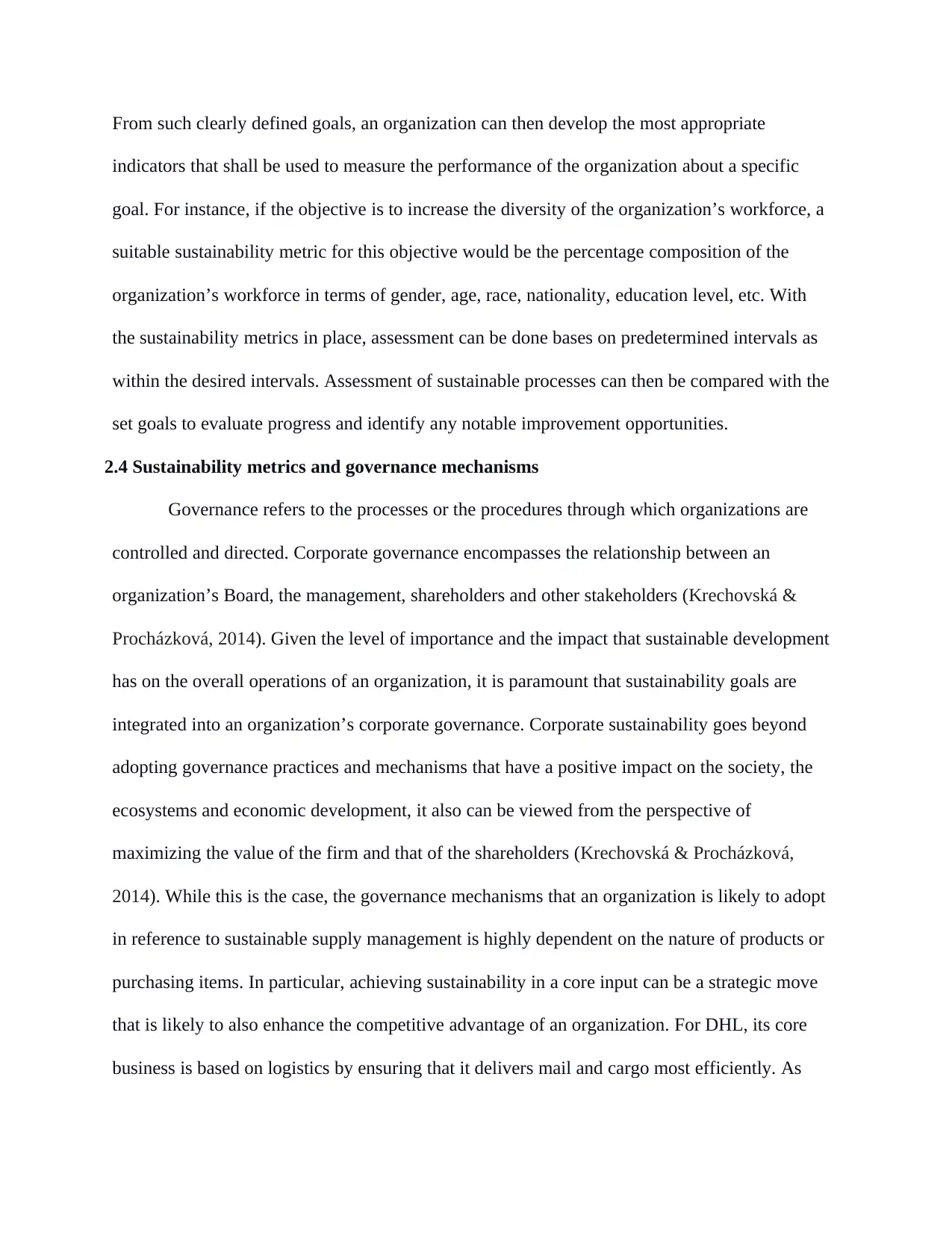
From such clearly defined goals, an organization can then develop the most appropriate
indicators that shall be used to measure the performance of the organization about a specific
goal. For instance, if the objective is to increase the diversity of the organization’s workforce, a
suitable sustainability metric for this objective would be the percentage composition of the
organization’s workforce in terms of gender, age, race, nationality, education level, etc. With
the sustainability metrics in place, assessment can be done bases on predetermined intervals as
within the desired intervals. Assessment of sustainable processes can then be compared with the
set goals to evaluate progress and identify any notable improvement opportunities.
2.4 Sustainability metrics and governance mechanisms
Governance refers to the processes or the procedures through which organizations are
controlled and directed. Corporate governance encompasses the relationship between an
organization’s Board, the management, shareholders and other stakeholders (Krechovská &
Procházková, 2014). Given the level of importance and the impact that sustainable development
has on the overall operations of an organization, it is paramount that sustainability goals are
integrated into an organization’s corporate governance. Corporate sustainability goes beyond
adopting governance practices and mechanisms that have a positive impact on the society, the
ecosystems and economic development, it also can be viewed from the perspective of
maximizing the value of the firm and that of the shareholders (Krechovská & Procházková,
2014). While this is the case, the governance mechanisms that an organization is likely to adopt
in reference to sustainable supply management is highly dependent on the nature of products or
purchasing items. In particular, achieving sustainability in a core input can be a strategic move
that is likely to also enhance the competitive advantage of an organization. For DHL, its core
business is based on logistics by ensuring that it delivers mail and cargo most efficiently. As
indicators that shall be used to measure the performance of the organization about a specific
goal. For instance, if the objective is to increase the diversity of the organization’s workforce, a
suitable sustainability metric for this objective would be the percentage composition of the
organization’s workforce in terms of gender, age, race, nationality, education level, etc. With
the sustainability metrics in place, assessment can be done bases on predetermined intervals as
within the desired intervals. Assessment of sustainable processes can then be compared with the
set goals to evaluate progress and identify any notable improvement opportunities.
2.4 Sustainability metrics and governance mechanisms
Governance refers to the processes or the procedures through which organizations are
controlled and directed. Corporate governance encompasses the relationship between an
organization’s Board, the management, shareholders and other stakeholders (Krechovská &
Procházková, 2014). Given the level of importance and the impact that sustainable development
has on the overall operations of an organization, it is paramount that sustainability goals are
integrated into an organization’s corporate governance. Corporate sustainability goes beyond
adopting governance practices and mechanisms that have a positive impact on the society, the
ecosystems and economic development, it also can be viewed from the perspective of
maximizing the value of the firm and that of the shareholders (Krechovská & Procházková,
2014). While this is the case, the governance mechanisms that an organization is likely to adopt
in reference to sustainable supply management is highly dependent on the nature of products or
purchasing items. In particular, achieving sustainability in a core input can be a strategic move
that is likely to also enhance the competitive advantage of an organization. For DHL, its core
business is based on logistics by ensuring that it delivers mail and cargo most efficiently. As
Paraphrase This Document
Need a fresh take? Get an instant paraphrase of this document with our AI Paraphraser
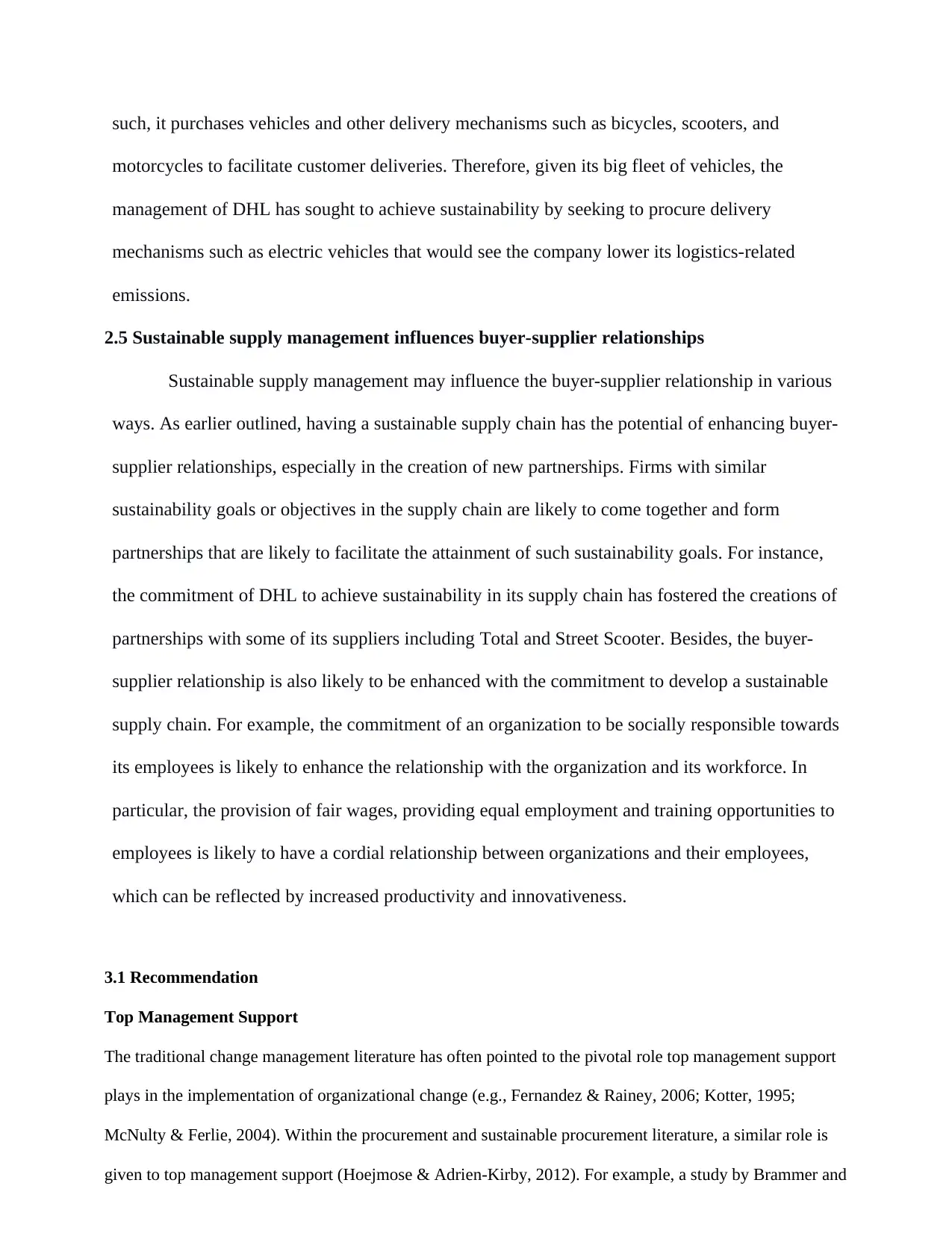
such, it purchases vehicles and other delivery mechanisms such as bicycles, scooters, and
motorcycles to facilitate customer deliveries. Therefore, given its big fleet of vehicles, the
management of DHL has sought to achieve sustainability by seeking to procure delivery
mechanisms such as electric vehicles that would see the company lower its logistics-related
emissions.
2.5 Sustainable supply management influences buyer-supplier relationships
Sustainable supply management may influence the buyer-supplier relationship in various
ways. As earlier outlined, having a sustainable supply chain has the potential of enhancing buyer-
supplier relationships, especially in the creation of new partnerships. Firms with similar
sustainability goals or objectives in the supply chain are likely to come together and form
partnerships that are likely to facilitate the attainment of such sustainability goals. For instance,
the commitment of DHL to achieve sustainability in its supply chain has fostered the creations of
partnerships with some of its suppliers including Total and Street Scooter. Besides, the buyer-
supplier relationship is also likely to be enhanced with the commitment to develop a sustainable
supply chain. For example, the commitment of an organization to be socially responsible towards
its employees is likely to enhance the relationship with the organization and its workforce. In
particular, the provision of fair wages, providing equal employment and training opportunities to
employees is likely to have a cordial relationship between organizations and their employees,
which can be reflected by increased productivity and innovativeness.
3.1 Recommendation
Top Management Support
The traditional change management literature has often pointed to the pivotal role top management support
plays in the implementation of organizational change (e.g., Fernandez & Rainey, 2006; Kotter, 1995;
McNulty & Ferlie, 2004). Within the procurement and sustainable procurement literature, a similar role is
given to top management support (Hoejmose & Adrien-Kirby, 2012). For example, a study by Brammer and
motorcycles to facilitate customer deliveries. Therefore, given its big fleet of vehicles, the
management of DHL has sought to achieve sustainability by seeking to procure delivery
mechanisms such as electric vehicles that would see the company lower its logistics-related
emissions.
2.5 Sustainable supply management influences buyer-supplier relationships
Sustainable supply management may influence the buyer-supplier relationship in various
ways. As earlier outlined, having a sustainable supply chain has the potential of enhancing buyer-
supplier relationships, especially in the creation of new partnerships. Firms with similar
sustainability goals or objectives in the supply chain are likely to come together and form
partnerships that are likely to facilitate the attainment of such sustainability goals. For instance,
the commitment of DHL to achieve sustainability in its supply chain has fostered the creations of
partnerships with some of its suppliers including Total and Street Scooter. Besides, the buyer-
supplier relationship is also likely to be enhanced with the commitment to develop a sustainable
supply chain. For example, the commitment of an organization to be socially responsible towards
its employees is likely to enhance the relationship with the organization and its workforce. In
particular, the provision of fair wages, providing equal employment and training opportunities to
employees is likely to have a cordial relationship between organizations and their employees,
which can be reflected by increased productivity and innovativeness.
3.1 Recommendation
Top Management Support
The traditional change management literature has often pointed to the pivotal role top management support
plays in the implementation of organizational change (e.g., Fernandez & Rainey, 2006; Kotter, 1995;
McNulty & Ferlie, 2004). Within the procurement and sustainable procurement literature, a similar role is
given to top management support (Hoejmose & Adrien-Kirby, 2012). For example, a study by Brammer and
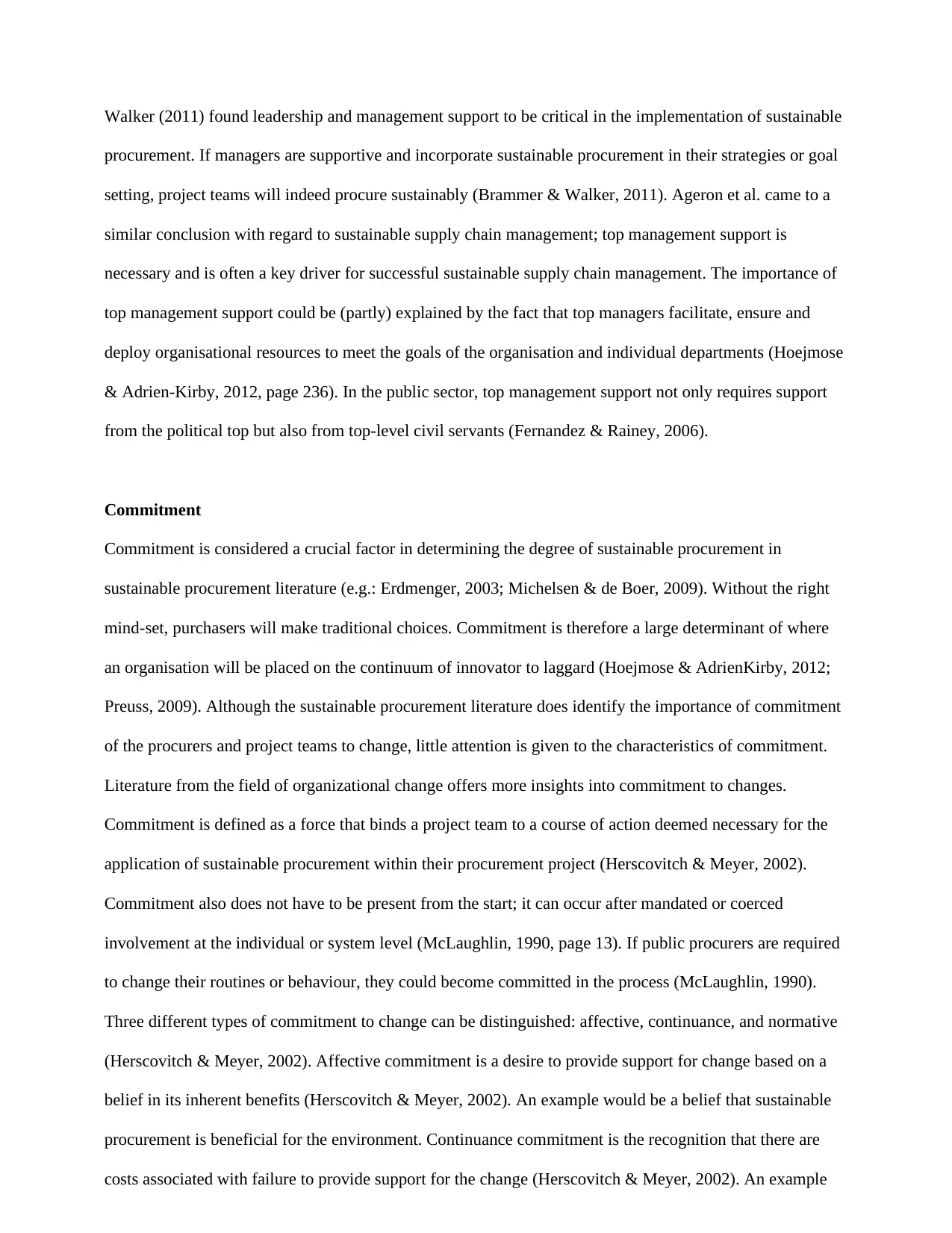
Walker (2011) found leadership and management support to be critical in the implementation of sustainable
procurement. If managers are supportive and incorporate sustainable procurement in their strategies or goal
setting, project teams will indeed procure sustainably (Brammer & Walker, 2011). Ageron et al. came to a
similar conclusion with regard to sustainable supply chain management; top management support is
necessary and is often a key driver for successful sustainable supply chain management. The importance of
top management support could be (partly) explained by the fact that top managers facilitate, ensure and
deploy organisational resources to meet the goals of the organisation and individual departments (Hoejmose
& Adrien-Kirby, 2012, page 236). In the public sector, top management support not only requires support
from the political top but also from top-level civil servants (Fernandez & Rainey, 2006).
Commitment
Commitment is considered a crucial factor in determining the degree of sustainable procurement in
sustainable procurement literature (e.g.: Erdmenger, 2003; Michelsen & de Boer, 2009). Without the right
mind-set, purchasers will make traditional choices. Commitment is therefore a large determinant of where
an organisation will be placed on the continuum of innovator to laggard (Hoejmose & AdrienKirby, 2012;
Preuss, 2009). Although the sustainable procurement literature does identify the importance of commitment
of the procurers and project teams to change, little attention is given to the characteristics of commitment.
Literature from the field of organizational change offers more insights into commitment to changes.
Commitment is defined as a force that binds a project team to a course of action deemed necessary for the
application of sustainable procurement within their procurement project (Herscovitch & Meyer, 2002).
Commitment also does not have to be present from the start; it can occur after mandated or coerced
involvement at the individual or system level (McLaughlin, 1990, page 13). If public procurers are required
to change their routines or behaviour, they could become committed in the process (McLaughlin, 1990).
Three different types of commitment to change can be distinguished: affective, continuance, and normative
(Herscovitch & Meyer, 2002). Affective commitment is a desire to provide support for change based on a
belief in its inherent benefits (Herscovitch & Meyer, 2002). An example would be a belief that sustainable
procurement is beneficial for the environment. Continuance commitment is the recognition that there are
costs associated with failure to provide support for the change (Herscovitch & Meyer, 2002). An example
procurement. If managers are supportive and incorporate sustainable procurement in their strategies or goal
setting, project teams will indeed procure sustainably (Brammer & Walker, 2011). Ageron et al. came to a
similar conclusion with regard to sustainable supply chain management; top management support is
necessary and is often a key driver for successful sustainable supply chain management. The importance of
top management support could be (partly) explained by the fact that top managers facilitate, ensure and
deploy organisational resources to meet the goals of the organisation and individual departments (Hoejmose
& Adrien-Kirby, 2012, page 236). In the public sector, top management support not only requires support
from the political top but also from top-level civil servants (Fernandez & Rainey, 2006).
Commitment
Commitment is considered a crucial factor in determining the degree of sustainable procurement in
sustainable procurement literature (e.g.: Erdmenger, 2003; Michelsen & de Boer, 2009). Without the right
mind-set, purchasers will make traditional choices. Commitment is therefore a large determinant of where
an organisation will be placed on the continuum of innovator to laggard (Hoejmose & AdrienKirby, 2012;
Preuss, 2009). Although the sustainable procurement literature does identify the importance of commitment
of the procurers and project teams to change, little attention is given to the characteristics of commitment.
Literature from the field of organizational change offers more insights into commitment to changes.
Commitment is defined as a force that binds a project team to a course of action deemed necessary for the
application of sustainable procurement within their procurement project (Herscovitch & Meyer, 2002).
Commitment also does not have to be present from the start; it can occur after mandated or coerced
involvement at the individual or system level (McLaughlin, 1990, page 13). If public procurers are required
to change their routines or behaviour, they could become committed in the process (McLaughlin, 1990).
Three different types of commitment to change can be distinguished: affective, continuance, and normative
(Herscovitch & Meyer, 2002). Affective commitment is a desire to provide support for change based on a
belief in its inherent benefits (Herscovitch & Meyer, 2002). An example would be a belief that sustainable
procurement is beneficial for the environment. Continuance commitment is the recognition that there are
costs associated with failure to provide support for the change (Herscovitch & Meyer, 2002). An example
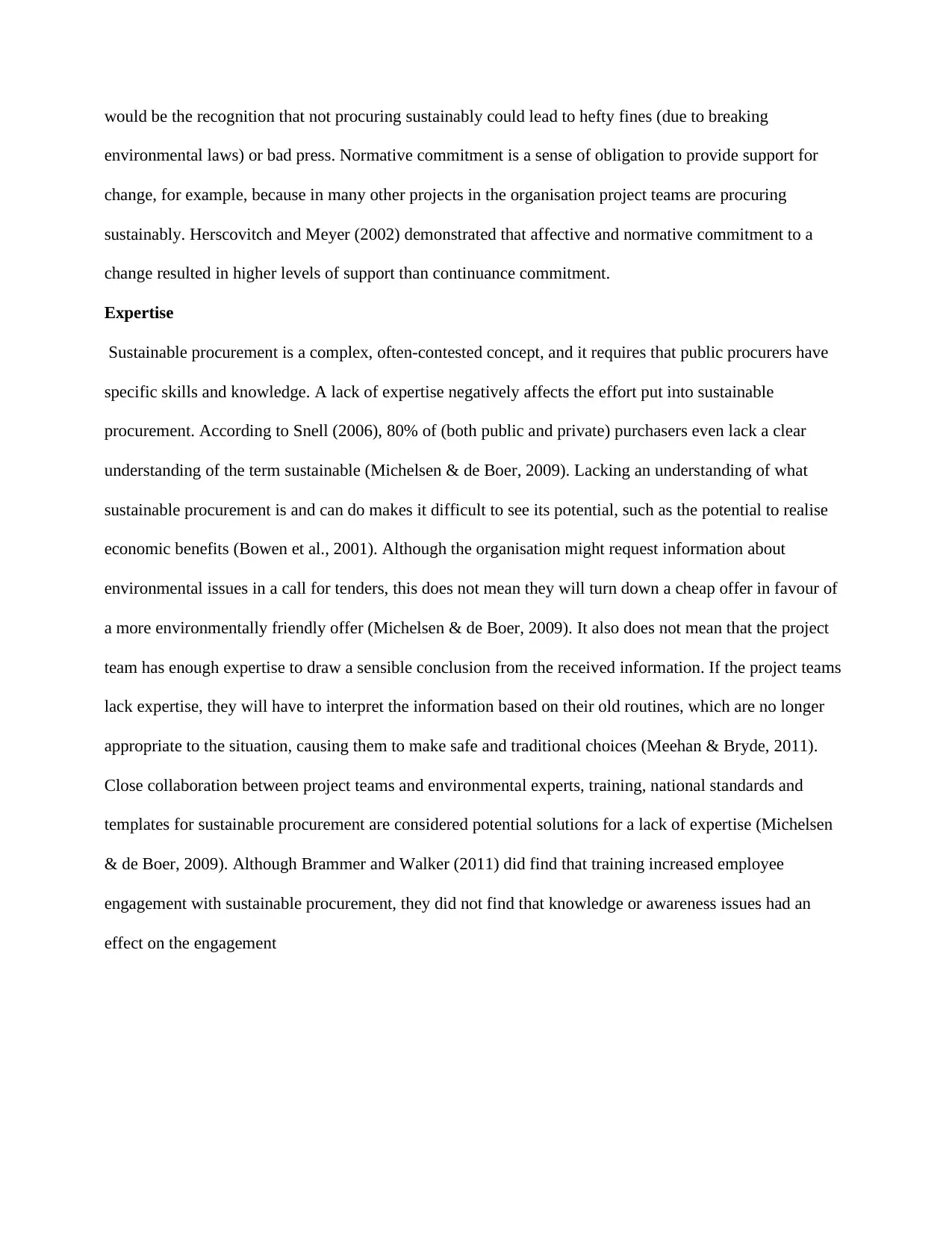
would be the recognition that not procuring sustainably could lead to hefty fines (due to breaking
environmental laws) or bad press. Normative commitment is a sense of obligation to provide support for
change, for example, because in many other projects in the organisation project teams are procuring
sustainably. Herscovitch and Meyer (2002) demonstrated that affective and normative commitment to a
change resulted in higher levels of support than continuance commitment.
Expertise
Sustainable procurement is a complex, often-contested concept, and it requires that public procurers have
specific skills and knowledge. A lack of expertise negatively affects the effort put into sustainable
procurement. According to Snell (2006), 80% of (both public and private) purchasers even lack a clear
understanding of the term sustainable (Michelsen & de Boer, 2009). Lacking an understanding of what
sustainable procurement is and can do makes it difficult to see its potential, such as the potential to realise
economic benefits (Bowen et al., 2001). Although the organisation might request information about
environmental issues in a call for tenders, this does not mean they will turn down a cheap offer in favour of
a more environmentally friendly offer (Michelsen & de Boer, 2009). It also does not mean that the project
team has enough expertise to draw a sensible conclusion from the received information. If the project teams
lack expertise, they will have to interpret the information based on their old routines, which are no longer
appropriate to the situation, causing them to make safe and traditional choices (Meehan & Bryde, 2011).
Close collaboration between project teams and environmental experts, training, national standards and
templates for sustainable procurement are considered potential solutions for a lack of expertise (Michelsen
& de Boer, 2009). Although Brammer and Walker (2011) did find that training increased employee
engagement with sustainable procurement, they did not find that knowledge or awareness issues had an
effect on the engagement
environmental laws) or bad press. Normative commitment is a sense of obligation to provide support for
change, for example, because in many other projects in the organisation project teams are procuring
sustainably. Herscovitch and Meyer (2002) demonstrated that affective and normative commitment to a
change resulted in higher levels of support than continuance commitment.
Expertise
Sustainable procurement is a complex, often-contested concept, and it requires that public procurers have
specific skills and knowledge. A lack of expertise negatively affects the effort put into sustainable
procurement. According to Snell (2006), 80% of (both public and private) purchasers even lack a clear
understanding of the term sustainable (Michelsen & de Boer, 2009). Lacking an understanding of what
sustainable procurement is and can do makes it difficult to see its potential, such as the potential to realise
economic benefits (Bowen et al., 2001). Although the organisation might request information about
environmental issues in a call for tenders, this does not mean they will turn down a cheap offer in favour of
a more environmentally friendly offer (Michelsen & de Boer, 2009). It also does not mean that the project
team has enough expertise to draw a sensible conclusion from the received information. If the project teams
lack expertise, they will have to interpret the information based on their old routines, which are no longer
appropriate to the situation, causing them to make safe and traditional choices (Meehan & Bryde, 2011).
Close collaboration between project teams and environmental experts, training, national standards and
templates for sustainable procurement are considered potential solutions for a lack of expertise (Michelsen
& de Boer, 2009). Although Brammer and Walker (2011) did find that training increased employee
engagement with sustainable procurement, they did not find that knowledge or awareness issues had an
effect on the engagement
Secure Best Marks with AI Grader
Need help grading? Try our AI Grader for instant feedback on your assignments.

4.1 Conclusion
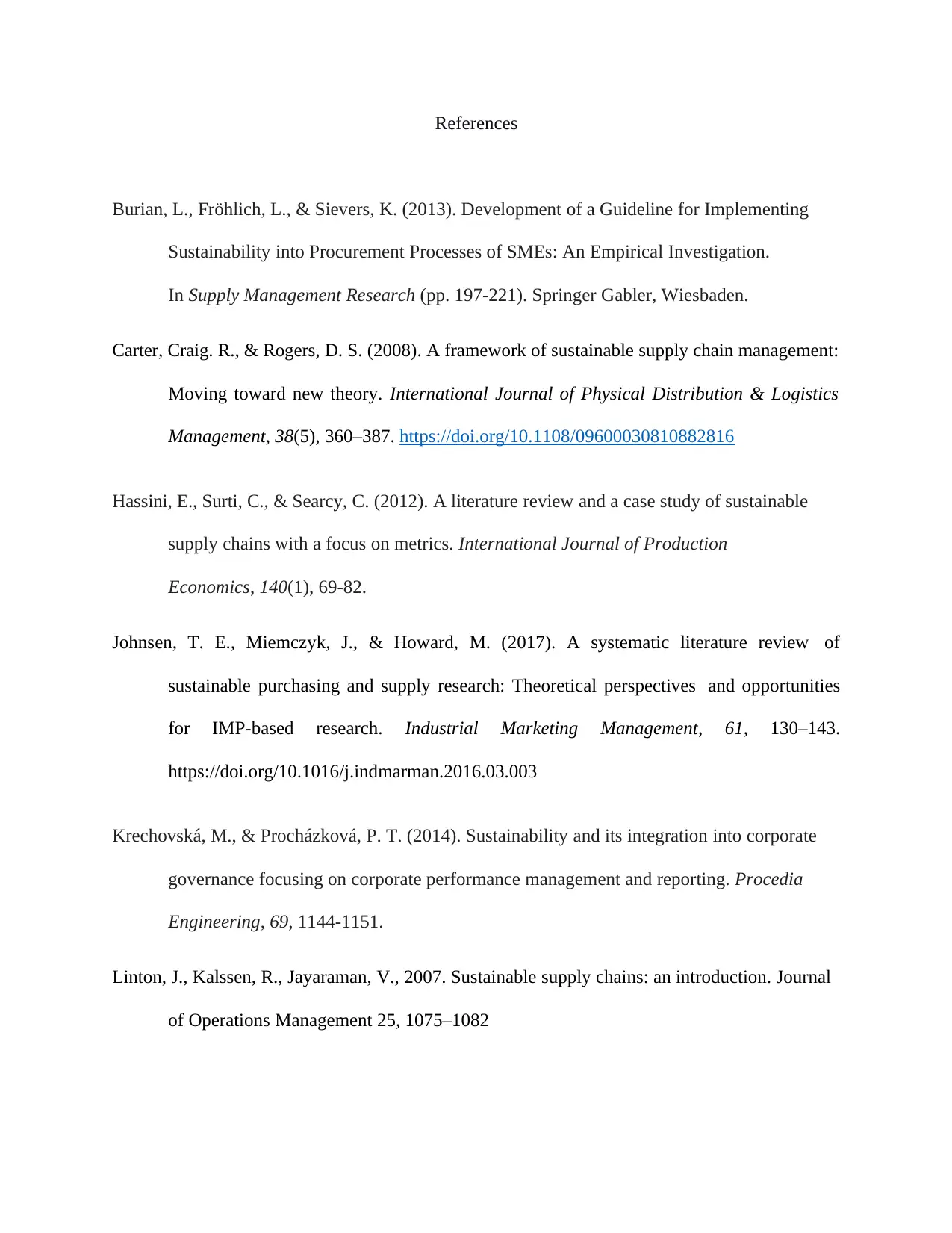
References
Burian, L., Fröhlich, L., & Sievers, K. (2013). Development of a Guideline for Implementing
Sustainability into Procurement Processes of SMEs: An Empirical Investigation.
In Supply Management Research (pp. 197-221). Springer Gabler, Wiesbaden.
Carter, Craig. R., & Rogers, D. S. (2008). A framework of sustainable supply chain management:
Moving toward new theory. International Journal of Physical Distribution & Logistics
Management, 38(5), 360–387. https://doi.org/10.1108/09600030810882816
Hassini, E., Surti, C., & Searcy, C. (2012). A literature review and a case study of sustainable
supply chains with a focus on metrics. International Journal of Production
Economics, 140(1), 69-82.
Johnsen, T. E., Miemczyk, J., & Howard, M. (2017). A systematic literature review of
sustainable purchasing and supply research: Theoretical perspectives and opportunities
for IMP-based research. Industrial Marketing Management, 61, 130–143.
https://doi.org/10.1016/j.indmarman.2016.03.003
Krechovská, M., & Procházková, P. T. (2014). Sustainability and its integration into corporate
governance focusing on corporate performance management and reporting. Procedia
Engineering, 69, 1144-1151.
Linton, J., Kalssen, R., Jayaraman, V., 2007. Sustainable supply chains: an introduction. Journal
of Operations Management 25, 1075–1082
Burian, L., Fröhlich, L., & Sievers, K. (2013). Development of a Guideline for Implementing
Sustainability into Procurement Processes of SMEs: An Empirical Investigation.
In Supply Management Research (pp. 197-221). Springer Gabler, Wiesbaden.
Carter, Craig. R., & Rogers, D. S. (2008). A framework of sustainable supply chain management:
Moving toward new theory. International Journal of Physical Distribution & Logistics
Management, 38(5), 360–387. https://doi.org/10.1108/09600030810882816
Hassini, E., Surti, C., & Searcy, C. (2012). A literature review and a case study of sustainable
supply chains with a focus on metrics. International Journal of Production
Economics, 140(1), 69-82.
Johnsen, T. E., Miemczyk, J., & Howard, M. (2017). A systematic literature review of
sustainable purchasing and supply research: Theoretical perspectives and opportunities
for IMP-based research. Industrial Marketing Management, 61, 130–143.
https://doi.org/10.1016/j.indmarman.2016.03.003
Krechovská, M., & Procházková, P. T. (2014). Sustainability and its integration into corporate
governance focusing on corporate performance management and reporting. Procedia
Engineering, 69, 1144-1151.
Linton, J., Kalssen, R., Jayaraman, V., 2007. Sustainable supply chains: an introduction. Journal
of Operations Management 25, 1075–1082
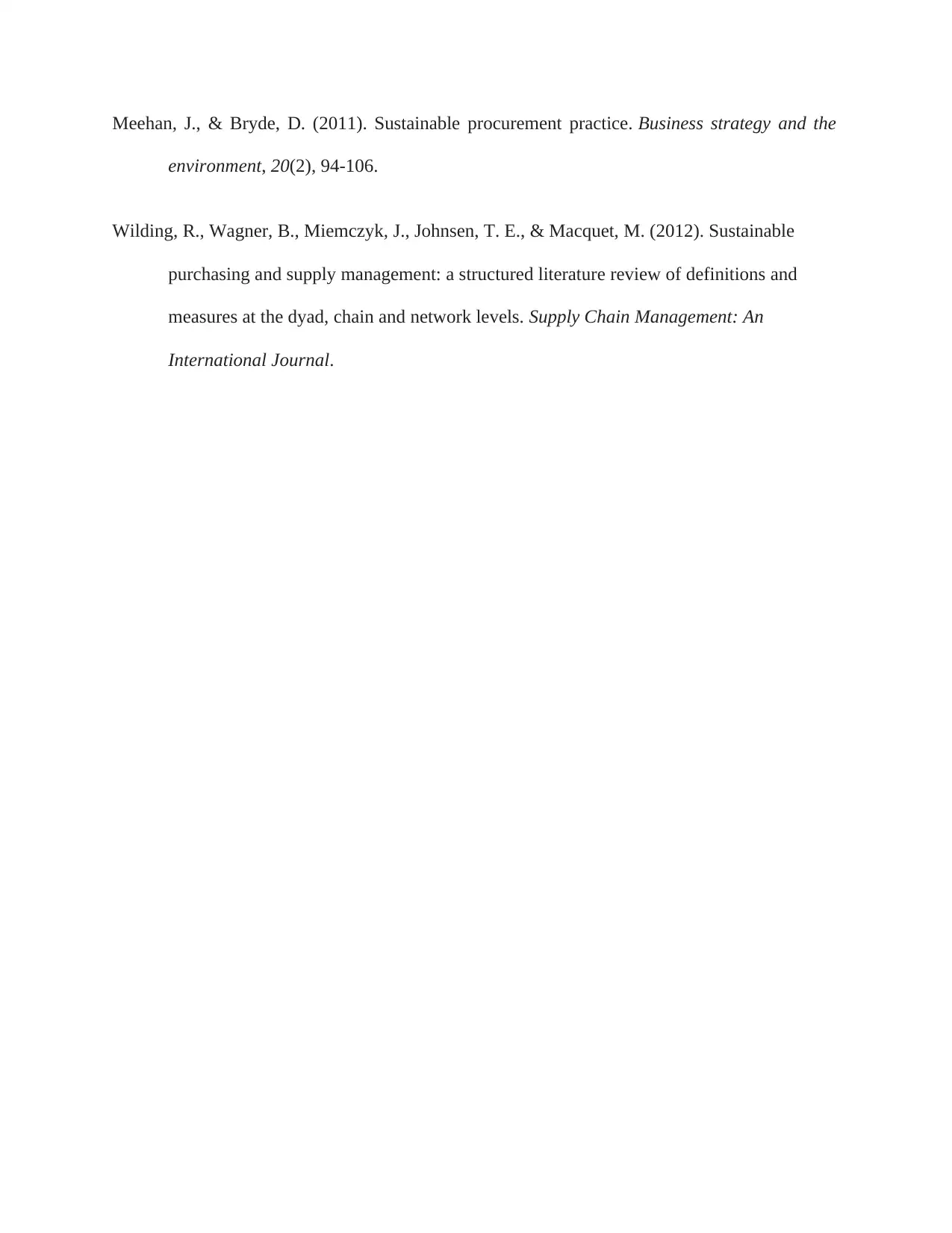
Meehan, J., & Bryde, D. (2011). Sustainable procurement practice. Business strategy and the
environment, 20(2), 94-106.
Wilding, R., Wagner, B., Miemczyk, J., Johnsen, T. E., & Macquet, M. (2012). Sustainable
purchasing and supply management: a structured literature review of definitions and
measures at the dyad, chain and network levels. Supply Chain Management: An
International Journal.
environment, 20(2), 94-106.
Wilding, R., Wagner, B., Miemczyk, J., Johnsen, T. E., & Macquet, M. (2012). Sustainable
purchasing and supply management: a structured literature review of definitions and
measures at the dyad, chain and network levels. Supply Chain Management: An
International Journal.
1 out of 13
Related Documents
Your All-in-One AI-Powered Toolkit for Academic Success.
+13062052269
info@desklib.com
Available 24*7 on WhatsApp / Email
![[object Object]](/_next/static/media/star-bottom.7253800d.svg)
Unlock your academic potential
© 2024 | Zucol Services PVT LTD | All rights reserved.





